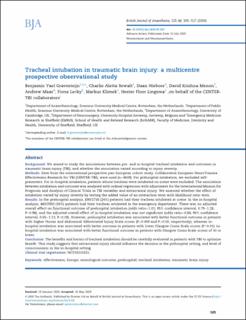| dc.contributor.author | Gravesteijn, BY | |
| dc.contributor.author | Sewalt, Charlie | |
| dc.contributor.author | Nieboer, D. | |
| dc.contributor.author | Menon, David K. | |
| dc.contributor.author | Maas, Andrew I. R. | |
| dc.contributor.author | Lecky, Fiona E. | |
| dc.contributor.author | Klimek, Markus | |
| dc.contributor.author | Lingsma, Hester F | |
| dc.contributor.author | Andelic, Nada | |
| dc.contributor.author | Andreassen, Lasse | |
| dc.contributor.author | Anke, Audny | |
| dc.contributor.author | Frisvold, Shirin | |
| dc.contributor.author | Helseth, Eirik | |
| dc.contributor.author | Skandsen, Toril | |
| dc.contributor.author | Røe, Cecilie | |
| dc.contributor.author | Røise, Olav | |
| dc.contributor.author | Vik, Anne | |
| dc.date.accessioned | 2022-11-24T15:02:33Z | |
| dc.date.available | 2022-11-24T15:02:33Z | |
| dc.date.created | 2020-08-30T10:34:53Z | |
| dc.date.issued | 2020 | |
| dc.identifier.citation | British Journal of Anaesthesia. 2020, 125 (4), 505-517. | en_US |
| dc.identifier.issn | 0007-0912 | |
| dc.identifier.uri | https://hdl.handle.net/11250/3033940 | |
| dc.description.abstract | Background: We aimed to study the associations between pre- and in-hospital tracheal intubation and outcomes in traumatic brain injury (TBI), and whether the association varied according to injury severity.
Methods: Data from the international prospective pan-European cohort study, Collaborative European NeuroTrauma Effectiveness Research for TBI (CENTER-TBI), were used (n=4509). For prehospital intubation, we excluded self-presenters. For in-hospital intubation, patients whose tracheas were intubated on-scene were excluded. The association between intubation and outcome was analysed with ordinal regression with adjustment for the International Mission for Prognosis and Analysis of Clinical Trials in TBI variables and extracranial injury. We assessed whether the effect of intubation varied by injury severity by testing the added value of an interaction term with likelihood ratio tests.
Results: In the prehospital analysis, 890/3736 (24%) patients had their tracheas intubated at scene. In the in-hospital analysis, 460/2930 (16%) patients had their tracheas intubated in the emergency department. There was no adjusted overall effect on functional outcome of prehospital intubation (odds ratio=1.01; 95% confidence interval, 0.79–1.28; P=0.96), and the adjusted overall effect of in-hospital intubation was not significant (odds ratio=0.86; 95% confidence interval, 0.65–1.13; P=0.28). However, prehospital intubation was associated with better functional outcome in patients with higher thorax and abdominal Abbreviated Injury Scale scores (P=0.009 and P=0.02, respectively), whereas in-hospital intubation was associated with better outcome in patients with lower Glasgow Coma Scale scores (P=0.01): in-hospital intubation was associated with better functional outcome in patients with Glasgow Coma Scale scores of 10 or lower.
Conclusion: The benefits and harms of tracheal intubation should be carefully evaluated in patients with TBI to optimise benefit. This study suggests that extracranial injury should influence the decision in the prehospital setting, and level of consciousness in the in-hospital setting. | en_US |
| dc.language.iso | eng | en_US |
| dc.publisher | Elsevier | en_US |
| dc.rights | Navngivelse 4.0 Internasjonal | * |
| dc.rights.uri | http://creativecommons.org/licenses/by/4.0/deed.no | * |
| dc.title | Tracheal intubation in traumatic brain injury: a multicentre prospective observational study | en_US |
| dc.type | Peer reviewed | en_US |
| dc.type | Journal article | en_US |
| dc.description.version | publishedVersion | en_US |
| dc.source.pagenumber | 505-517 | en_US |
| dc.source.volume | 125 | en_US |
| dc.source.journal | British Journal of Anaesthesia | en_US |
| dc.source.issue | 4 | en_US |
| dc.identifier.doi | 10.1016/j.bja.2020.05.067 | |
| dc.identifier.cristin | 1826048 | |
| dc.relation.project | Norges forskningsråd: 272789 | en_US |
| dc.relation.project | EU/602150 | en_US |
| cristin.ispublished | true | |
| cristin.fulltext | original | |
| cristin.qualitycode | 2 | |

